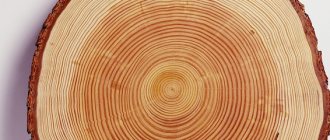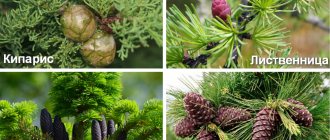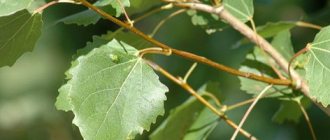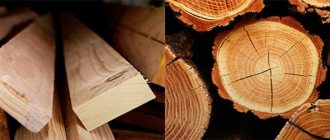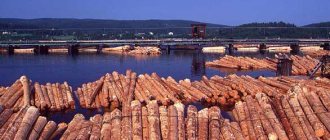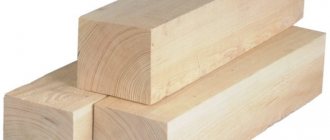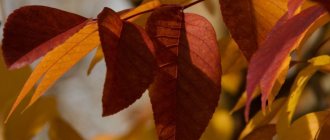Botanical description
Larches are large, straight-trunked trees . Adult specimens in the wild reach a height of up to 30–40 m, rarely lower than 23 m. The diameter of the lower part of the trunk reaches 1.5 m. The root system is taprooted, the depth of penetration depends on the soil. In permafrost conditions it is superficial, with a large number of adventitious roots. The bark is brown or dark gray in color, thickens with age and becomes fissured.
The crowns are sparse, young trees have a regular cone shape . In adulthood they become wide and ovoid. Young shoots are slightly pubescent, yellowish, pink or light brown in color. The needles are soft to the touch, flattened, bright green, 2–4 cm long. They are located on the shoots in large bunches or spirally.
Larches are monoecious: one tree contains characters of both sexes . Female cones are short, bright pink or brownish in color, about 3 cm long, with large rounded scales. Males are up to 1.5 cm in length, ovoid, yellowish. The seeds are small, winged, ripen by October, and can hang in closed cones until next spring. Trees reach fruiting age at 15–17 years. In summer, mature cones with wide open scales resemble rose flowers. The needles begin to turn yellow and fall off in mid-September; in some species they persist until late autumn. The cones continue to hang on the branches all winter.
Larches are undemanding to the level of soil nutrition: they grow on sandy, silty, rocky soils, and swamps. They are sensitive to lack of sunlight and die in deep shade. In well-lit areas they develop quickly: the annual growth of young trees reaches 80–100 cm.
Thanks to the tough, thick bark, larch trunks are fire-resistant . Trees survive forest fires and fill burnt wastelands. The lifespan of these breeds is about 500 years. There are specimens over 800 years old.
Building material assessment
- Price – 3. Products made from pine can be many times more expensive than similar ones made from other types of wood.
- Practicality – 5. There are buildings and individual elements (piles, supports) that function for several centuries. The foundations of many wooden houses in Venice are made from larch over 500 years ago.
- Appearance – 5. Like most noble trees, larch is used without external coloring. The beautiful wood texture gives the product a special flavor.
- Ease of manufacture - 3. You can mechanically prepare the surface for coating with varnish or oil yourself, while it is better to entrust more delicate work to a professional carpenter.
- Labor intensity during use – 4. The low density of dried wood simplifies the installation and movement of deciduous structures, and its high hardness and strength make it difficult to fine-tune the component parts on site.
- Environmental friendliness - 5. The material is used to make the interior decoration of baths and saunas, and old larch barrels are used for aging wines.
Larch wood is one of the optimal materials for the construction of baths, saunas and exterior decoration of the house. The significant cost of buildings pays off with long-term use of larch products, which can be used by several generations of the family.
A few more words about larch:
Kinds
There are about 20 species of larches in nature. As a result of interspecific pollination, many of them form hybrid forms. Common types of wood:
- Siberian. It grows in the Northern Urals, Siberia, Sayan Mountains, Altai, and grows in mixed forests in flat areas and in the mountains up to 2900 meters above sea level. Often inhabits old burnt areas and wastelands. The height of the trees is up to 35–40 m. The crowns are openwork, pyramidal. The young bark is light brown, smooth, becomes brown with age, and can peel off in plates. The Siberian species is cold-resistant, prefers turf or podzolic soils, and loves moisture. Can exist in urban environments.
- Western. It grows in Canada, in the northeastern United States, rising to 2500 meters above sea level. The tallest species. The length of the trunks is up to 80 m. The crowns are narrow and pyramidal. The needles are soft, bright green, the needles are about 3 cm long. The cones are oblong, light brown, up to 5 cm long.
- Japanese or fine-scaled. A Far Eastern species growing on the Japanese islands, Sakhalin, and the Kuril Islands. The trees reach a height of 28–30 m. The crowns are cone-shaped and openwork. The needles are bluish-green, needles up to 5 cm long, spirally arranged. The bark is reddish or rufous, lighter than that of other species. This larch prefers fertile soils, grows slowly, stretches 20 cm per year.
- European. Distributed in the Alps, forests of the Carpathians, Western Europe. The trees reach a height of 30–40 m. The crowns have a wide pyramidal or irregular shape. The needles are bluish-green. The bark is brownish-gray, fissured. The species is drought-resistant, does not tolerate waterlogging, and grows on any soil. Life expectancy is up to 400 years or more.
- Daurskaya. The second name is Gmelin larch. Distributed in areas of Eastern Siberia. The trees grow up to 35 m in height, the crowns have a pyramidal shape, and in open, windy areas they become irregular and one-sided. The needles are bright green, 2–3 cm long. The cones are light green. The most cold-resistant and hardy species. It grows on marshy soils, in the mountains, and tolerates drought well.
- Primorskaya. Hybrid variety. It grows in the Far East: in some areas of the Primorsky Territory, on Sakhalin. Trees are up to 25 m high. The needles are bluish in color. The crowns are narrow pyramidal. Cones up to 5 cm long.
All varieties of larches shed their needles annually. In September or October it turns yellow and flies around. In May, the shoots are covered with new needles.
Larch diseases
Ella Sokolova , Candidate of Agricultural Sciences
Fungal diseases are the most widespread on larch. Plants in nurseries, forests and urban areas are affected. The disease poses the highest danger to larches in nurseries, crops and young plantings.
Needle diseases
Rust (caused by the fungus Melampsoridium betulinum). Different types of larch and birch are affected, the diseased leaves of which are a source of infection for the larch. In the first half of summer, sporulation of the pathogen forms on the lower side of the needles in the form of orange or yellow small bubbles located along the midrib.
Schutte , or meriosis (pathogen is the fungus Meria laricis). Different types of larch are affected, but larch is most severely affected. Siberian and L. Daurian, or Gmelina. The first signs of the disease appear approximately 10–14 days after germination. Initially, individual brown spots form at the tips of the needles, which quickly grow, covering the entire needle. The affected needles become reddish-brown, curl slightly, die and soon fall off, which is one of the signs of meriosis. During the summer, several generations (generations, spores) are formed that carry out repeated infections of needles.
Browning of needles (caused by the fungus Hypodermella laricis). Different types of larch are affected, but most often larch. Siberian In summer, the needles become reddish-brown in color and curl easily. On the underside of dead needles, fruiting bodies of the fungus are formed, which look like black leathery elongated, flat or slightly convex pads up to 1 mm long. The disease is not widespread, but in some regions it occurs in large numbers.
Yellowing of needles (caused by the fungus Mycosphaerella laricina). Different types of larch are affected. The first signs of the disease on the needles appear in late May - early June. Initially, individual yellowish blurry spots form on the needles. Later they become brown, merge and cover most of the surface of the needles. The sporulation of the fungus looks like small dark pads protruding from under the epidermis.
Diseases of needles lead to their premature, often massive fall, causing weakening and sometimes death of young plants.
Diseases of needles lead to their premature, often massive fall, causing weakening and sometimes death of young plants.
Diseases of trunks, branches, roots
Step cancer (caused by the fungus Lachnellula willkommii). Different types of larch are affected, but larch is most severely affected. Siberian and L. European.
Separate sections of dead bark first appear on trunks and branches. Later, tarred wounds form at the site of necrosis. On the branches they are small, but on the trunks they are perennial, stepped. Along the edges of the wounds, fruiting bodies of the pathogen are formed in the form of cups with a diameter of 2–4 mm, white on the outside, orange-pink on the inside, which serve as a characteristic sign of the disease. Step cancer leads to weakening and death of larch in crops and young plantings.
Rot diseases affect trees older than 40 years. An external characteristic sign of rot is the fruiting bodies of the pathogens, which vary in shape, size, color, and consistency.
Root rots are caused by root sponge (Heterobasidion annosum), autumn honey fungus (Armillaria mellea), and Schweinitz polypore (Phaeolus schweinitzii). When affected by these fungi, rot from the roots rises into the trunk to a height of up to 2 m.
Trunk rot is caused by larch (Fomitopsis officinalis), pine (Porodaedalea pini) sponges, fringed (Fomitopsis pinicola), and sulfur-yellow (Laetiporus sulphureus) polypores. Rot develops in the core part of the trunks and, depending on the type of pathogen, rises to a height of 4 to 20 m.
Rot diseases lead to weakening and drying out of individual trees and entire plantings. Sick trees have reduced resistance to wind, which contributes to the formation of windfalls and windbreaks. Due to rot damage, the yield of industrial wood is reduced. Sick trees are infested with stem pests, which accelerate their death.
Protection of larch from diseases includes preventive and exterminatory measures:
- surveillance of the emergence and spread of diseases;
- creating optimal conditions for the growth and development of plants, which increases resistance to disease;
- pruning and destruction of shrunken and cancer-affected branches, which are a source of infection;
- timely sanitary felling to limit the spread of root rot;
- in nurseries and young plantings, spraying plants during the growing season with protective fungicides against pine needle diseases;
- in nurseries and young plantings, autumn spraying of fallen pine needles in order to destroy pathogens with eradicating fungicides.
Application
Medicine
The areas of application are numerous. Needles, buds, bark, plant resin are raw materials for the pharmaceutical industry. Contain a complex of biochemical active substances, including:
- lignins,
- tanning compounds,
- vitamins,
- flavonoids,
- alkaloids,
- essential oil,
- catechins,
- minerals.
Decoctions and infusions of herbs, buds, and young bark are used to treat infectious diseases, pathologies of the gastrointestinal tract, cardiovascular, immune systems, and musculoskeletal system.
Larch resin is an effective biostimulant with antiseptic, strengthening, anti-inflammatory, and regenerating properties. The resin is included in dietary supplements, natural medicines, and cosmetic products.
Wood
The wood is a sound species, has a high density, and is not subject to deformation or rotting. This is a reddish-brown, heavy, hard material with a contrasting natural pattern, slightly inferior in technical characteristics to oak. Well polished, suitable for exterior and interior use. Due to the high resin content, it can last up to 70–100 years without loss of properties .
Larch is used to produce:
- linings,
- flooring,
- timber,
- panels for finishing the walls of houses,
- furniture,
- door panels,
- window frames
Wood does not suffer from moisture or temperature changes, holds all types of fasteners well, and has excellent biostability. Logs are used for pillar construction of foundations and permanent fences. Even being deep in the soil, the material does not deteriorate for several decades.
Waste lumber is used to produce charcoal, alcohol, paper, and cellulose.
Landscape design
Resistance to adverse natural influences and beautiful appearance make the tree suitable for landscaping and use in landscape design. You can grow decorative varieties and ordinary larch in your local area. Most species lend themselves well to pruning and crown formation. Dwarf species are used as tapeworms in group plantings. These trees coexist well with almost any coniferous and deciduous shrubs .
Application of larch wood
It is used in underwater structures, used for sewer pipes, window frames, construction, ornamental and shipbuilding logs, balance sheets, sleepers, power poles, and mine stands. This breed also occupies a worthy place in furniture and plywood production.
This tree is 30% denser and stronger than pine, more resistant to dampness and damage by putrefactive fungi. Siberians say that one larch will outlast two or three pine trees. A larch building can last two or three centuries. But entire houses from larch were rarely cut down due to the hardness of the wood - only a few lower crowns were laid from larch logs.
Larch can remain in water for many centuries. After lying in water for a long time, it becomes very hard. That is why it went to the construction of bridges, piers and piers. It was on larch piles that its creator Montferrand decided to erect St. Isaac's Cathedral on the marshy soils of St. Petersburg. Larch wood was used to make telegraph poles, antennas, sleepers, mine stands, the most important wooden structures and parts for ships, and end pavements.
Until the middle of the 19th century. In Russia, it was forbidden by law to sell larch wood to private individuals - too much of it was required for military and commercial shipbuilding (and even now there are restrictions on its use). An exception was made during the construction of the Winter Palace, St. Basil's Cathedral, the Moscow Kremlin cathedrals, the Manege (now the Central Exhibition Hall in Moscow), where the frames and ceilings were made of larch wood.
Festive and ritual utensils were cut from the root wood. In Zagorsk there is a ladle with a capacity of one and a half buckets. The ladle was hollowed out in the 18th century. from larch root by a Volga master. The wood of this tree is also “musical”. Its high acoustic properties were used in the 17th century. during the manufacture of an organ in the Polish city of Kazimierz.
Tree bark is also a valuable raw material. Taiga residents get red-brown paint from it. Durable textile dyes are produced from larch bark, essential oils and tannins are extracted.
Landing
It is recommended to select seedlings from nurseries. Good material has flexible shoots and bright needles without yellowness. The age of the most suitable specimens is 2–4 years. Work is carried out in April or September.
The site for larches should be sunny, without close groundwater . Acidic soil is undesirable. Heavy clay soil should be diluted with sand and a small amount of lime.
Holes for seedlings are prepared with a depth and width twice the size of the root system . Equal parts of peat and turf soil are added to the excavated soil. The bottom can be lined with a 10–15 cm layer of drainage. The root collar is not buried: it must remain at surface level.
After planting, the tree is watered abundantly and mulched with a thick layer of sawdust or dry pine needles.
Care
The soil near the plantings must be kept clean by weeding out. It is necessary to loosen the soil around the plants to a depth of 7–10 cm. Young seedlings need a lot of moisture, so watering should be frequent and plentiful, once a week, 20 liters of water for each trunk. Trees older than 5 years survive on natural rainfall.
Fertilize the plantings twice a season. For this purpose, complex mineral compositions, potassium additives, liquid organic solutions, humus, and peat are used.
Larch trees are not insulated for the winter. In severe frosts, young shoots can be covered with snow so that the root system is not damaged. Mature trees do not suffer from cold weather.
Crowns are trimmed for sanitary purposes in the spring, after the snow melts. The emerging haircut is carried out in June. During the season, you can cut up to ⅓ of the length of the shoots; during the growing season they quickly recover.
Larch in landscaping
Olga Nikitina
Thanks to its rapid growth and openwork crown with delicate bright green needles, turning golden in autumn, larch is a very valuable species for gardening construction. Its decorative low-growing forms fit well into the landscape of garden plots, adding spectacular accents to various compositions.
Usage
Larches look very impressive at all times of the year: in winter - with a clearly visible, slender crown architecture, in summer - in an amazingly beautiful green outfit, in autumn - with brightly colored golden foliage. But in the spring, this tree becomes a real triumph, when male and female strobiles appear on weakly leafy shoots. At this time, it is worthy of the artist’s pen and the attention of a photographer. Yellow, round male strobili are located on the same shoot with delightful raspberry-pink cones.
The decorative qualities of this breed are somewhat reduced due to its ability to shed needles for the winter. However, this same property, on the one hand, makes larch resistant to smoke and air pollution in an urban environment, and on the other hand, it allows it to be covered in delicate, fragrant emerald needles in the spring, which turn golden or straw-yellow tones in the fall.
Larches are traditional park trees. Being huge in size, they perfectly form spaces in large gardens and parks and are indispensable for creating alley plantings and loose groups. Many of the species we cultivate have interesting decorative forms that fit harmoniously into small gardens, creating accents in a variety of compositions.
The abundance of light in larch plantations allows the introduction of an undergrowth of beautiful flowering shrubs, such as forsythia, rhododendrons, brooms, lilacs, and mock oranges. Larch goes well with various types of maples, pines and spruces.
Decorative varieties of this breed, mostly grafted, having small sizes and various crown shapes (conical, spherical, long, weeping on trunks of various heights), are used to create interesting garden compositions, including other ornamental plants.
Strict conical low-growing forms can be planted on the sides at the entrance to the house, create small alleys, use in row plantings and group plantings on the lawn, while using the same configurations, or play with the contrast of the outlines of the crowns.
The weeping forms of larches look very attractive; their use in garden design can be very diverse: as a tapeworm on the lawn, near a pond, near recreation areas. In addition, decorative varieties with a vertical accent can be used in compositions with shrubs and herbaceous perennials. Quite original wood compositions are obtained from weeping forms of larch, grafted onto trunks of different heights.
Almost all types of larches tolerate pruning well, so they can be used to form interesting shapes, for example, a ball on a tree trunk, give the crown the appearance of a pyramid, or create hedges; however, they will not be very dense, but very effective. Even old specimens are pruned, as a result of which they become noticeably “younger” and turn into trees with a spreading crown.
Larches have a beneficial effect on the human psyche; they heal melancholy and depression. We feel especially comfortable walking along the larch alleys.
Larches perfectly form spaces in large gardens and parks and are indispensable for creating alley plantings and loose groups.
Types and varieties
Let's look at the most commonly used larches in landscape design and their decorative forms.
European larch is a very valuable, fast-growing tree up to 35 m high with light green and golden-yellow needles in autumn. For good development it needs free standing. It goes well with pines, spruces, as well as deciduous trees and shrubs that turn red in autumn. The most common varieties:
'Conica' is a cultivar bred in France, in which the lower part of the trunk has horizontal branches, while the upper ones are much shorter and form a conical shape.
'Compacta' is a dwarf form with a dense conical crown, which is formed by dense and very brittle branches. 'Corley' is a slow growing form, without a leading shoot, rounded. It looks quite original, vaguely reminiscent of a witch’s broom.
'Kellermannii' is a bush-like dwarf with very dense short and thick shoots, densely covered with leaves. 'Pendula' is a tall light-loving and winter-hardy tree with unevenly spaced and sparse branches, the ends of the shoots drooping.
'Repens' is a dwarf form with long branches spreading over the ground.
Looks great in group and alley plantings. Daurian, characterized by high winter hardiness. In mixed groups it goes well with various types of maples. To create small garden compositions, you can use its dwarf forms (f. pumila and f. prostrata), which combine very harmoniously with heathers and eriks, as well as other low-growing tree species.
deserves wider use in gardening construction . American in the form of solitary and group plantings, especially on highly moist soils. Its decorative form with blue needles (f. glauca) is good both in single plantings and in mixed ones, where it plays the role of a color accent.
Fast growing l. western reaches its best development in well-drained, rich and moist soils. The narrow pyramidal crown and significant height (up to 50 m) turn it into a beautiful accent tree that will be a worthy decoration for both single and group plantings.
The most in demand in green construction is l. Japanese - it is quite resistant to pests and diseases and tolerates city conditions well. In addition, this species is superior to all others in its decorativeness and is distinguished by its unusual crown structure, which is made up of branches extending horizontally from the trunk, as well as long needles and the shape of the cones, reminiscent of a blossoming miniature rose. In mixed plantings it goes well with junipers, pines, spruces, lindens, oaks, ash trees and many ornamental shrubs.
It has a number of original decorative forms:
'Blue Rabbit' is a very beautiful tree with a narrow conical crown and bluish needles. A wonderful accent in color compositions.
'Diana' is a tree up to 10 m high, the branches are slightly twisted in a spiral, it is demanding on soils, prefers well-drained fertile loams and sandy loams, does not tolerate drought and stagnant water. Used in solitary, group and alley plantings.
'Pendula' is a tree up to 10 m high with a weeping crown and soft bluish-green needles. A very decorative form, used in single and group plantings.
'Wolterdingen' is a wonderful dwarf form with a crown diameter greater than the height of the plant. The needles are bluish-green and slightly curled. A worthy decoration for small, intimate gardens and rocky hills.
The abundance of light in larch plantations allows the introduction of an undergrowth of beautiful flowering shrubs, such as forsythia, rhododendrons, brooms, lilacs, and mock oranges.
Diseases and parasites
The most dangerous cancer for larches is the one that attacks trunks and needles. Its signs: shiny smooth spots on the bark, deep ragged cracks, increased gumming. Symptoms of fusarium and other fungal infections: yellowing or browning needles, the appearance of reddish specks, bald spots, rusty or black spots on the bark.
For treatment, Bordeaux mixture, sulfur solution, Fundazol, Zinebom and other fungicides are used. Tinder fungi are removed from the bark by treating it with copper sulfate or Nitrofen.
Of the parasites, larch is annoyed by leaf roller caterpillars, moths, cap moths, sawflies, bark beetles, aphids, and pine bugs. For prevention and pest control, Fozalon and Karbofos are used.
Larch pests
Tamara Galasyeva , Candidate of Agricultural Sciences
Larch is damaged by about 300 species of insects and herbivorous mites, which are found on all vegetative and generative parts of the plant.
Needle-eating insects
Needle-eating insects damage buds, young shoots and needles. They are quite numerous and are represented by species from various families of butterflies, sawflies and beetles. Among them there are monophages, oligophages and polyphags, feeding on needles and even foliage of other tree species.
The feeding of needle-eating insects begins from the moment the buds swell and the needles bloom and continues throughout the growing season. The most harmful among them are the Siberian silkworm (Dendrolimus sibirica) and the larch leaf roller (Semasia diniana). Outbreaks of these pests occur periodically in the larch forests of Siberia over large areas.
On a smaller scale, outbreaks of the gypsy moth, ancient moth, Jacobson's moth and a number of other lepidoptera are present. Of the Hymenoptera in larch plantations, outbreaks of mass reproduction are formed by the large larch sawfly (Lygaeonematus erichsonii), the green larch sawfly (L. Wesmaeli) and some other species. In total, 15 species of sawflies feed on larch needles; Some species eat needles grown on last year's shoots and branches, while others eat only on current year's shoots. In this case, the ends of the damaged shoots bend in a certain way and die.
Typical damage to needles is caused by the larch cap moth (Coleophore laricella). The caterpillar of the cap moth lives and feeds inside a light brown cap about 0.5 cm long. The caterpillar mines the middle part of the needle, which causes its tip to dry out. Caterpillars in sheaths attach to needles and overwinter in them on the branches and trunks of larch, climbing into cracks in the bark.
The larch gall midge fly (Dasineura laricis) lives only in the buds. Buds damaged by larvae swell up to 1 cm in height, turn red and do not bloom. When the pest population is high, the tree crown thins out, becomes deformed, and sometimes dies, especially in young trees.
Needle-eating pests actively damage not only needles, but also buds and young shoots. They begin to feed from the moment the buds swell and the needles bloom and continue throughout the entire growing season.
Sucking pests
Sucking pests feed on the sap of buds, shoots, trunks with smooth bark and even roots. Larch is damaged by herbivorous mites, leafhoppers, psyllids, aphids, Hermes, bugs and thrips. The most important and widespread are Hermes, the body of which is covered with white fluff.
Characteristic signs of the colonization of trees by Hermes are white or bluish fluff at the base of whorls and on individual needles or abundant fluff and drops of transparent sticky secretions on May shoots. The most harmful species of hermes on larch include the larch subbark hermes (Cholodkovskya viridana), which lives under the scales of the bark of stems and branches. When it multiplies abundantly, it noticeably suppresses young trees; the needles on them are not completely overgrown or have a pale green color, and sometimes acquire a purple tint.
Hermes flying onto spruce cause more damage to spruce than to larch. On spruce they form galls on growing shoots, looking like small cones of green and pinkish-green color.
Two species of herbivorous mites feed on larch buds, of which the larch bud mite (Eriophyes) causes the greatest damage. Mite-infested buds are round, with tightly pressed scales. By the time they dry out, they are 3–4 times the size of normal, unexpanded buds.
The needles on young shoots are sucked out by mites of the genus Paratetranychus. During mass reproduction, it causes curvature of shoots and twisting of needles. Harmful in nurseries, forest crops and undergrowth. The root aphid (Pemphigus piceae) feeds on the sap of fine roots.
Stem pests
A large group of pests of wood and bark of trunks, branches and roots are xylophagous insects. These are dozens of species of bark beetles, longhorned beetles, borers, weevils, grinders, borers, bostrichids, horntails, etc.
All of them settle on severely weakened, drying out and dead trees (dead wood, dead wood, stumps and cut timber). Many are technical pests, gnawing deep holes in wood and reducing its quality or rendering it unusable. The most dangerous are xylophages that are capable of colonizing living, growing, but slightly weakened trees. Therefore, foci of stem pests usually occur in burnt areas, clearings and in plantings damaged by pine-eating insects.
Pioneer xylophages that colonize the trunks of weakened larches in various parts of its range are the large larch bark beetle (Ips subelongatus), the black-blue horntail (Paururus ermak), the larch borer (Phaenops guttulata) or the Altai longhorned beetle (Xylotrechus altaicus).
Some species of carpenter ants often settle on dry roadsides and in the hollows of growing larches. Longhorn beetles of the genera Callidium and Archopalus and ants of the genus Camponotus can develop in the wood of larch structures.
In total, 15 species of sawflies feed on larch needles.
Cones and seeds
Several types of pests develop in cones and seeds. The larch fly Hylemyia laricicola causes especially great damage to forestry. The spruce cone moth, larch leaf roller, larch cone gall midge and seed eaters are very harmful. Cones damaged by pests are often deformed, releasing drops of resin or insect excrement. Crossbills, squirrels, chipmunks and flying squirrels feed on the seeds in the growing cones. Fallen seeds are eaten mainly by mice.
Reproduction
Seed propagation of larches at home gives results if the material is tested for germination. This can be done by pouring water over the seeds. After 5 minutes, the ones that float up are removed: they are not suitable. The remaining ones are dried and sent for stratification. The material is mixed with sand, poured into linen bags, and stored in the refrigerator at a temperature of 4–6 °C for two months.
Sow in loose warm soil in spring . Sprinkle the material on top with a mixture of sand and peat in a layer 1–2 cm thick. Moisten it every 2 days. The sprouts are thinned out when they reach 5 cm. The seedlings are grown into full-fledged seedlings in the beds or by being transplanted directly to permanent places.
You can get new plants faster by cuttings . For rooting, take the apical or middle parts of lignified shoots 15–20 cm long. The lower cuts are made at an angle of 45° and treated with growth stimulants. The cuttings are placed in a peat mixture, deepened by ¼ of the length. After 4–5 weeks, young roots appear, the material is planted in tubs or open ground in a permanent place.
